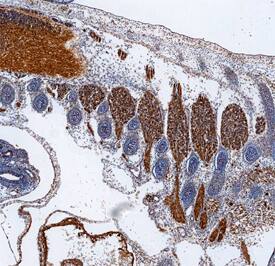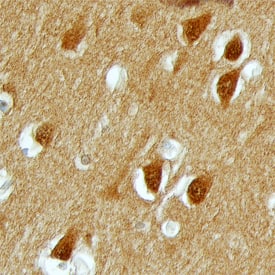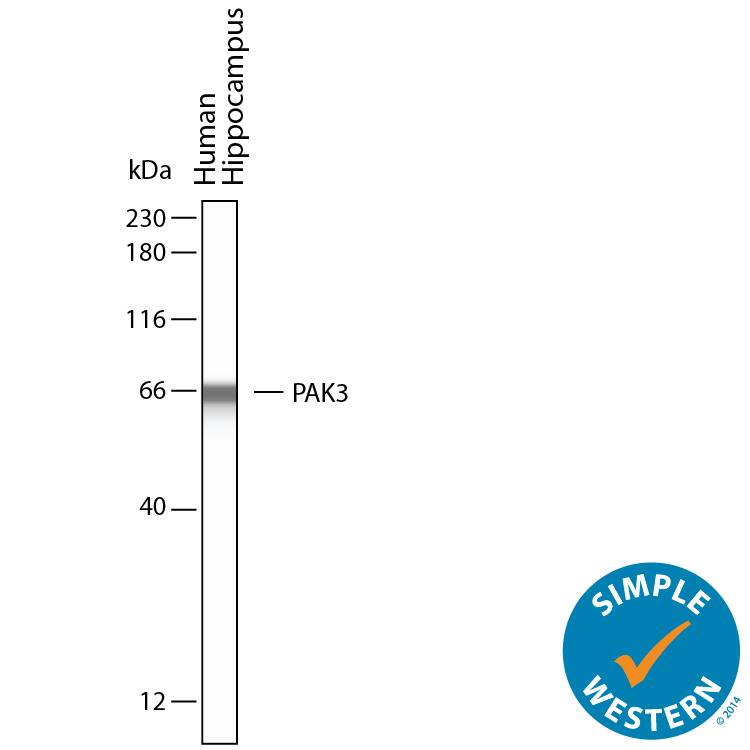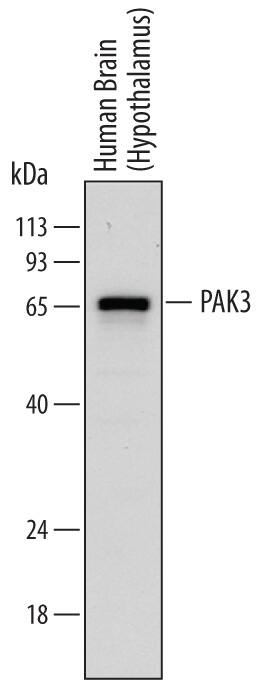Human/Mouse PAK3 Antibody
R&D Systems, part of Bio-Techne | Catalog # AF6897

Key Product Details
Species Reactivity
Applications
Label
Antibody Source
Product Specifications
Immunogen
Leu138-Gln255
Accession # O75914
Specificity
Clonality
Host
Isotype
Scientific Data Images for Human/Mouse PAK3 Antibody
Detection of Human PAK3 by Western Blot.
Western blot shows lysates of human brain (hypothalamus) tissue. PVDF membrane was probed with 0.25 µg/mL of Sheep Anti-Human PAK3 Antigen Affinity-purified Polyclonal Antibody (Catalog # AF6897) followed by HRP-conjugated Anti-Sheep IgG Secondary Antibody (Catalog # HAF016). A specific band was detected for PAK3 at approximately 65 kDa (as indicated). This experiment was conducted under reducing conditions and using Immunoblot Buffer Group 1.PAK3 in Mouse Embryo.
PAK3 was detected in immersion fixed frozen sections of mouse embryo (15 d.p.c.) using Sheep Anti-Human PAK3 Antigen Affinity-purified Polyclonal Antibody (Catalog # AF6897) at 1.7 µg/mL overnight at 4 °C. Tissue was stained using the Anti-Sheep HRP-DAB Cell & Tissue Staining Kit (brown; Catalog # CTS019) and counterstained with hematoxylin (blue). Specific staining was localized to the cytoplasm of neuronal cells. View our protocol for Chromogenic IHC Staining of Frozen Tissue Sections.PAK3 in Human Brain.
PAK3 was detected in immersion fixed paraffin-embedded sections of human brain (hippocampus) using Sheep Anti-Human PAK3 Antigen Affinity-purified Polyclonal Antibody (Catalog # AF6897) at 3 µg/mL overnight at 4 °C. Tissue was stained using the Anti-Sheep HRP-DAB Cell & Tissue Staining Kit (brown; Catalog # CTS019) and counterstained with hematoxylin (blue). Specific staining was localized to neuronal cell bodies and processes. View our protocol for Chromogenic IHC Staining of Paraffin-embedded Tissue Sections.Applications for Human/Mouse PAK3 Antibody
Immunohistochemistry
Sample: Immersion fixed frozen sections of mouse embryo (15 d.p.c.), and immersion fixed paraffin-embedded sections of human brain (hippocampus)
Simple Western
Sample: Human hippocampus
Western Blot
Sample: Human brain (hypothalamus) tissue
Formulation, Preparation, and Storage
Purification
Reconstitution
Formulation
*Small pack size (-SP) is supplied either lyophilized or as a 0.2 µm filtered solution in PBS.
Shipping
Stability & Storage
- 12 months from date of receipt, -20 to -70 °C as supplied.
- 1 month, 2 to 8 °C under sterile conditions after reconstitution.
- 6 months, -20 to -70 °C under sterile conditions after reconstitution.
Background: PAK3
PAK3 (p21-activaed kinase 3; also beta-PAK, PAK3b and oligophrenin-3) is a cytoplasmic 68 kDa member of PAK group I, STE20 subfamily, STE Ser/Thr protein kinase family of molecules. It is expressed in neurons of cortical layers II, III and V, the arcuate nucleus, and neurons in the dorsal raphe plus locus coeruleus. PAK3 mediates axon and dentrite arborization, providing volume to the mass of the CNS. It binds to active GTPases which induce PAK autophosphorylation and activation. Human PAK3(b) is 559 amino acids (aa) in length. It contains one GTPase binding domain (aa 68-128) plus a protein kinase catalytic region (aa 283-534). Acetylation occurs on Lys535, and there are at least three potential phosphorylation sites. Alternate splicing generates three isoform variants. There is a 65 kDa short form that shows a deletion of aa 93-107 (PAK3a), a 69 kDa long form that shows a 21 aa substitution for aa 93-107 (PAK3c), and a 72 kDa very long isoform that contains the aforementioned 21 aa "substitution" inserted onto PAK3b after Thr92 (PAK3cb). PAK3b, c and cb are all constitutively active, and show only modest binding affinity towards GTPases. Over aa 138-255, human PAK3(b) shares 94% aa identity with mouse PAK3(b).
Long Name
Alternate Names
Gene Symbol
UniProt
Additional PAK3 Products
Product Documents for Human/Mouse PAK3 Antibody
Product Specific Notices for Human/Mouse PAK3 Antibody
For research use only



